Ford Fairmont
The Ford Fairmont is a compact car that was produced by Ford for the US and Canada markets for the 1978 to 1983 model years.[2] The debut of the Fairmont and its Mercury Zephyr counterpart marked the launch of the long-running Ford Fox platform that would underpin twelve additional models and stay in production until 1993. Offered in a variety of body styles, the Fairmont succeeded the Ford Maverick, and was replaced by the front-wheel drive Ford Tempo for the 1984 model year.
| Ford Fairmont | |
|---|---|
 1981 Ford Fairmont four-door sedan | |
| Overview | |
| Manufacturer | Ford Motor Company |
| Also called | Mercury Zephyr Ford Elite II (Mexico) Ford Zephyr (Venezuela) Ford Futura (Venezuela) |
| Production | 1977–1983 |
| Model years | 1978–1983 |
| Assembly | United States: Claycomo, Missouri United States: Mahwah, New Jersey Canada: St. Thomas, Ontario Venezuela: Valencia, Carabobo Mexico: (La Villa Assembly Plant) |
| Body and chassis | |
| Class | Compact |
| Body style | 2-door coupe 2-door sedan 4-door sedan 4-door station wagon |
| Layout | FR layout |
| Platform | Ford Fox platform |
| Related | Ford Durango |
| Powertrain | |
| Engine | 140 cu in (2.3 L) Lima I4 140 cu in (2.3 L) Turbocharged Lima I4 200 cu in (3.3 L) Thriftpower Six I6 255 cu in (4.18 L) Windsor V8 302 cu in (4.95 L) Windsor V8 |
| Transmission | 3-speed manual 4-speed manual 3-speed C3 automatic 3-speed C4 automatic 3-speed C5 automatic |
| Dimensions | |
| Wheelbase | 105.5 in (2,680 mm) |
| Length | 193.8 in (4,920 mm) |
| Width | 71.0 in (1,800 mm) |
| Curb weight | 2,747–2,959 pounds (1,246–1,342 kg)[1] |
| Chronology | |
| Predecessor | Ford Maverick |
| Successor | Ford Tempo |
Background and development
In April 1973 the American EPA released its comprehensive list of fuel economy results.[3]:150[4] In October of the same year the 1973 oil crisis started. At the time Ford's North American product line included the subcompact Pinto and Mustang II, and the compact Maverick, but replacements for all of these models would soon be needed. At the same time Ford of England's Cortina line was in need of refreshing, as was the Taunus model built by Ford of Germany.[3]:151
Changes were also happening at Ford's executive level, as William O. Bourke, ex-chairman of Ford of Europe and one-time managing director of Ford of Australia, was made executive vice president of North American Operations and Robert Alexander, previously with Ford of Europe as vice president in charge of car development, moved to same position in the States.[5]:112
Hal Sperlich was vice-president of Product Planning and Research at Ford.[6] A proponent of downsizing, Sperlich conceived of a "World Car" that could be sold in both Europe and North America as a solution to the needs of the various divisions.[3]:150, 151
In December 1973 Ford President Lee Iacocca formally approved development of the Fox platform.[7]:96 The name of the platform was borrowed from the Audi 80, sold in the US and Australia as the Audi Fox.[8]:257 Ford's European executives, many now back in the States, considered the 80 their class-leading subcompact competitor and made it the baseline reference for the new platform.[9]:165, 166
Although the Fairmont would be the first Fox-based car to reach the market, development was guided by an anticipated sport coupe to be based on the new platform.[7]:99
Development started in early 1973 on both a short-wheel base version to replace the Pinto/Cortina/Taunus lines and a long-wheelbase version that would become the Fairmont.[3]:151 By 1974 the difficulties faced in meeting the conflicting regulatory requirements in different markets and differing production methods used by the various divisions had killed the world car idea.[10]:12 In 1975 North American Automobile Operations took over development of the Fox platform from Sperlich's Product Planning and Research group.
The first running Fox/Fairmont prototype was a modified Cortina with a MacPherson strut and torsion bar front suspension.[3]:151
A Fairmont Futura coupe built on 15 November 1977 at the Mahwah, New Jersey factory was the one-hundred millionth vehicle produced by Ford.[11]
A 1980 Fairmont station wagon converted to an electric vehicle by Electric Vehicles Associates Inc. and renamed the EVA Current Fare Wagon was evaluated by the US Department of Energy from March 1980 to November 1981.[12]
Model overview
The Ford Fairmont was launched in August 1977 as a 1978 model.[13] The name was first used by Ford in 1965 for the Australian Fairmont, an upscale trim level model of the Ford Falcon (XP), and had also been used in the South African market in 1969.
Chassis specifications
The Fairmont is based on the rear-wheel drive Ford Fox platform, using steel unibody construction. The independent front suspension comprised lower lateral arms, MacPherson struts, and helical-wound coil springs. In what Ford called a modified or hybrid MacPherson strut system, the coil springs were mounted separately from the struts rather than concentrically, being located between the lower arm and front cross-member. A front anti-roll bar was standard equipment. The rear suspension used a solid axle suspended on coil springs and vertically mounted dampers. The axle was located by four links; two lower trailing arms and two sharply angled upper control arms.
The Fairmont has power-assisted brakes, with 10.0 inch vented front discs and 9.0 x 1.8 inch rear drums. Standard wheels and tires were 14x5.0 and DR78-14 respectively.[14]:32, 33 Steering was by a rack and pinion system with 3.2 turns lock-to-lock.
Powertrain
For its entire production run, the standard engine for the Fairmont was a 140 cu in (2.3 L) inline-4 (shared with the Pinto). Initially producing 88 hp, following several revisions, output rose to 90 hp to 1983. The 2.3L engine was initially paired with a 3-speed manual (replaced by a 4-speed in 1979), with a 3-speed automatic offered as an option. For 1980 only,[15] a 120 hp turbocharged version of the 2.3L engine (shared with the Mustang Cobra) was available in Fairmont sedans and coupes. Examples with the turbocharged engine were distinguished by a center-mounted hood "power bulge".
As an option, a 200 cu in (3.3 L) inline-6 (shared with the Maverick and Granada) was offered from 1978 to 1983 model years. While offering less horsepower than the 2.3L inline-4, the 3.3L inline-6 produced significantly more torque. For 1978, the standard transmission was a 3-speed manual (replaced by a 4-speed for 1979); a 3-speed automatic was offered as an option.
For 1978 to 1981 model years, the Fairmont was offered with two different Windsor V8 engines (shared with mid-size and full-size Ford vehicles). For 1978 and 1979, a 139 hp 302 cu in (4.9 L) V8 was offered, available with a 4-speed manual transmission for the 1979 model year only. It was replaced by a 115 hp 255 cu in (4.2 L) V8 for 1980 and 1981. The 255 engine was paired exclusively with a 3-speed automatic transmission.
| Engine family | Year(s) | Bore x Stroke | Displacement | Valvetrain | Induction | Carburetion | Horsepower | Torque |
|---|---|---|---|---|---|---|---|---|
| Lima Inline-4 | 1978–1981 | 3.78 in × 3.13 in (96.04 mm × 79.4 mm) | 140 cu in (2,301 cc) | SOHC | Naturally aspirated | 2-barrel[16][17][18] | 88 hp at 4800 rpm[16] | 118 lb-ft at 2800 rpm[16] |
| 1982 | 86 hp at 4600 rpm[17] 92 hp at 4600 rpm[18] |
117 lb-ft at 2600 rpm[17] 119 lb-ft at 4600 rpm[18] | ||||||
| 1983 | 1-barrel[19] | 90 hp at 4600 rpm[19] | 122 lb-ft at 2600 rpm[19] | |||||
| 1980 | Turbocharged | 2-barrel (Draw-through)[20] | 120 hp at 5400 rpm[20] | 145 lb-ft at 3000 rpm[20] | ||||
| Thriftpower Inline-6 | 1978–1979 | 3.69 in × 3.13 in (93.6 mm × 79.4 mm) | 200 cu in (3,278 cc) | OHV | Naturally aspirated | 1-barrel[21] | 85 hp at 3600 rpm[21] | 154 lb-ft at 1600 rpm[21] |
| 1980–1983 | 91 hp at 3800 rpm[22] | 160 lb-ft at 1600 rpm[22] | ||||||
| Windsor V8 | 1978–1979 | 4.00 in × 3.00 in (101.6 mm × 76.2 mm) | 302 cu in (4,942 cc) | OHV | Naturally aspirated | 2-barrel[23] | 139 hp at 3600 rpm[23] | 250 lb-ft at 1600 rpm[23] |
| 1980 | 3.68 in × 3.00 in (93.5 mm × 76.2 mm) | 255 cu in (4,183 cc) | 2-barrel[24][25] | 119 hp at 3800 rpm[24] | 194 lb-ft at 2200 rpm[24] | |||
| 1981 | 115 hp at 3400 rpm[25] | 195 lb-ft at 2200 rpm[25] |
Body design
The Fairmont debuted for 1978 with three body configurations; a two-door sedan, a four-door sedan, and a five-door station wagon. Late in the 1978 model year, a two-door coupe was introduced; named Futura, the name revived the sporty trim level used for the 1960s Ford Falcon.
The Fairmont Futura was developed from a Fairmont-based Thunderbird design proposal from March 1976.[26] The Futura was a two-door coupe distinguished by a model-specific roofline that featured a wrapover B-pillar similar to the 1977–1979 Ford Thunderbird but without opera windows. The rear fascia was also given its own wrap-around taillamp design. To further differentiate the Futura from the standard Fairmont, the coupe was fitted with the 4-headlight fascia from the Zephyr, and a cross-hatched grille was used in place of the standard eggcrate grille. For the 1980 model year Ford expanded the Futura nameplate to include a four-door sedan and added a Futura station wagon for 1981.
For 1981, the exterior trim was revised with the addition of a slim molding strip along the side exterior panels; convenience equipment was also increased. For 1982, several model revisions were made. Ford moved the Fairmont station wagon to the Granada model line and the Futura trim became the sole trim,[27] expanding it to the two-door sedan for the first time. Effectively, this standardized the four-headlight front fascia (of the Futura coupe and Mercury Zephyr).
For 1983, Ford introduced an "S" model of the Fairmont Futura as a base trim.[28] Sold only as a sedan and only with the 2.3L engine, the radio and right-hand mirror of the Futura S became options.[29]
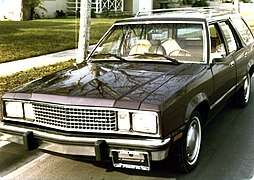 1978–1980 Ford Fairmont wagon
1978–1980 Ford Fairmont wagon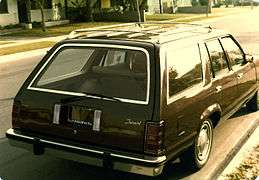 Ford Fairmont wagon
Ford Fairmont wagon.jpg) 1978–1980 Ford Fairmont two-door sedan
1978–1980 Ford Fairmont two-door sedan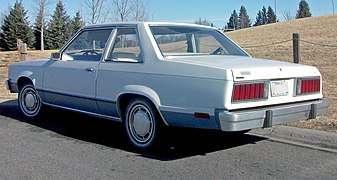 1978–1980 Ford Fairmont two-door sedan
1978–1980 Ford Fairmont two-door sedan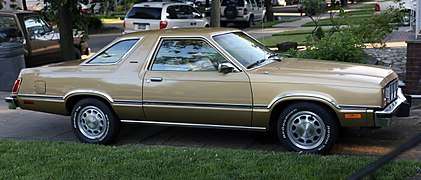 1980 Fairmont Futura
1980 Fairmont Futura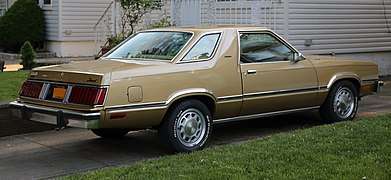 1980 Fairmont Futura
1980 Fairmont Futura
Discontinuation
During the early 1980s, Ford undertook a major revision of its product ranges. As Ford expanded its use of front-wheel drive vehicles into the compact and mid-size segment, the use of the rear-wheel drive Fox platform shifted away from family cars. After the 1983 model year, the Fairmont and Zephyr ended production. Released in 1983 (as early 1984 models), the front-wheel-drive Ford Tempo and Mercury Topaz succeeded the Fairmont and Zephyr.
As Ford returned the Ford Blue Oval emblem to North American vehicles in 1983, the Fairmont was the sole model line to use "FORD" badging (as it was in the final year of its model cycle); the Thunderbird (which has its own emblem) never used it on the grille.
Mercury Zephyr
From the 1978 to 1983 model years, the Mercury Zephyr served as the Mercury counterpart of the Ford Fairmont, as a replacement for the Maverick-based Comet. The third vehicle to use the nameplate within Ford Motor Company, the Mercury Zephyr shares its nameplate with the 1936–1940 Lincoln-Zephyr and the 1950–1972 Ford Zephyr (produced by Ford of Britain). Within the Mercury line, the Zephyr was slotted between the Bobcat (replaced for 1981 by the Lynx) and the Monarch (replaced for 1981 by the Cougar).
Alongside the Fairmont, the Zephyr was produced as two-door and four-door sedans, a five-door station wagon, and a two-door coupe (the Zephyr Z-7). Externally, the Zephyr shared design elements from Mercury vehicles of the early 1980s (including the Lynx, Capri, Cougar, and Marquis), including a waterfall-style grille, horizontally-ribbed taillamps, and (non-functional) front fender vents. At its launch, the Zephyr was distinguished by four headlights (shared only with the Fairmont Futura); for 1980, the headlight configuration was standardized for both the Fairmont and Zephyr.
Initially offered in standard, ES (a successor to the ESS trim of the Monarch), and Ghia trims, for 1981, both were replaced by GS trim (the equivalent of Futura on non-coupe Fairmonts). In line with other Mercury vehicles, a Villager woodgrained station wagon was produced.
At the beginning of the 1980s, the Zephyr was gradually phased out of the Mercury model line. Mercury shifted both the 4.2-liter V8 engine and the station wagon to the Cougar for the 1982 model year. As Mercury transitioned its model line to front-wheel drive, the Zephyr was replaced by the Mercury Topaz, introduced as an early 1984 model.
Following its use by Mercury, the Zephyr name was used by Lincoln a second time, for the 2006 Lincoln Zephyr. For 2007, the Zephyr was renamed the Lincoln MKZ as part of the use of "MK" nameplates by Lincoln.
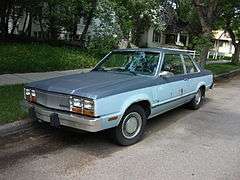 Mercury Zephyr two-door sedan
Mercury Zephyr two-door sedan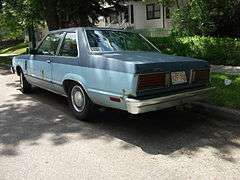 Mercury Zephyr two-door sedan
Mercury Zephyr two-door sedan.jpg) 1978 Mercury Zephyr Z-7
1978 Mercury Zephyr Z-7.jpg) 1978 Mercury Zephyr Z-7
1978 Mercury Zephyr Z-7.jpg) 1978 Mercury Zephyr Z-7
1978 Mercury Zephyr Z-7 1979 Mercury Zephyr station wagon
1979 Mercury Zephyr station wagon.jpg) 1978 Mercury Zephyr Villager
1978 Mercury Zephyr Villager
Variants
Ford Durango

The Ford Durango was produced by a joint venture between Ford and National Coach Corporation in 1981. Based heavily on the Fairmont Futura coupe, the Durango was a two-door, two-seat car-based pickup truck that was intended as a possible replacement for the 1977–1979 Ford Ranchero as well as a competitor to the downsized Chevrolet El Camino/GMC Caballero. Approximately 200 are estimated to have been produced.
European Sport Option
The European Sport Option was an appearance and suspension package offered in 1978 through 1980. It is abbreviated "ES Option" or "ESO". Exterior changes included a black grille, black cowl grille, deluxe bumpers, black window frames, black exterior mirrors, black C-pillar ventilation louvers, bright belt moldings and turbine wheel covers. The interior featured black carpeting, a black three-spoke leather-wrapped steering wheel, black instrument panel with gray engine-turned trim and black or chamois-colored seats. The running gear was modified with stiffer springs, re-valved shocks, and a rear anti-roll bar. The ESO mounted DR78-14 radial tires on 5.5 inch wheels, one half inch wider than stock.[14]:32[30]:33
Police and Taxicab packages
In 1978 Ford also made available specially prepared Fairmonts suitable for use as police cars and taxicabs. Initially the only engines offered for these applications were the 200 cubic inch inline six or the 302 V8.[31] Ford's product literature lists the following special features for both packages:
- Automatic transmission with first-gear lockout
- Externally-mounted transmission oil cooler
- Power brakes
- Heavy-duty body construction with extra reinforcements
- Heavy-duty suspension package (Police or Taxi), including higher-rate springs, hardened spindles, special shocks and struts
- Cooling package with high fin-density radiator
- Heavy-duty 14 x 5.5 inch wheels
In later years the naturally-aspirated 2.3L inline four engine became available as well.
A few turbo four-door automatic sedans were used for testing by the California Highway Patrol.
Other markets
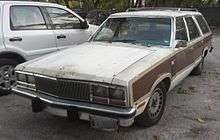
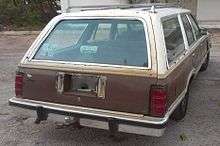
Mexico
The Ford Fairmont was introduced in Mexico in late 1977 as a 1978 model, replacing the Ford Maverick that was produced there locally. The Mexican Fairmont was available exclusively with the 5.0 L engine (302) with manual and three-speed automatic transmissions. It was offered as a two- or four-door sedan and a wagon. The Futura coupe with its distinctive Thunderbird-style roofline was never offered in Mexico. Instead there was an uplevel two-door sedan called the Fairmont Elite. It was distinguished from other Fairmonts by its higher level of equipment and vinyl roof. It used the four headlight grille from the Fairmont Futura along with the Mercury Zephyr's taillamps and rear quarter window louvers. For 1981, all versions of the Fairmont got four headlights. The regular Fairmont continued to use the Futura grille while the Fairmont Elite used the Mercury Zephyr grille.[32]
For 1982 the Fairmont Elite was renamed the Ford Elite II, and was offered in both two- and four-door sedans. The Elite II used the entire front end and matching rear bumper from the 1982 North American Ford Granada. The base Fairmont adapted the Mercury Zephyr grille used on the previous Elite.[33]
For 1983, the Fairmont received a new 3.8 L Essex V6 engine which was sold in addition to the existing V8. This was the last year of the Fairmont as it was replaced later by the Ford Topaz which was a hybrid assembly of the Mercury Topaz with a Ford Tempo front end.
Reception
Contemporary reviews were generally favorable, with many commenting on the "European" feel of the car and comparing it to the Volvo 200 series.[14]:27[30][37]
The 1978 Fairmont has been called the "most efficient Ford family (sedan) ever built from a space-per-weight perspective."[5]:112
Motorsports
In 1978 Bob Glidden campaigned an NHRA Pro Stock Futura powered by a Cleveland V8. The car won its debut race on 8 July 1978 at the Edgewater Winston Championship Series, where it also set a national record. Additional wins followed at the NHRA Grandnational, U.S. Nationals, Fall Nationals, World Finals and Beech Bend WCS. Glidden won his third national championship title with the car. The Futura was retired at the end of the 1978 season.[5]
See also
| Wikimedia Commons has media related to Ford Fairmont (North America). |
| Wikimedia Commons has media related to Mercury Zephyr. |
References
- "1980 Mercury Zephyr 1977 specifications". Archived from the original on 24 March 2012. Retrieved 2018-09-23.
- "Ford (USA) Fairmont data catalogue". www.automobile-catalog.com. Retrieved 2018-06-17.
- Leffingwell, Randy (4 March 2002). Mustang - The Original Muscle Car. Motorbooks International. ISBN 9781610591003.
- "Technical Report: History and Description of the EPA Motor Vehicle Fuel Economy Program". nepis.epa.gov. September 1982.
- Magnante, Steve (15 January 2010). How to Build Altered Wheelbase Cars. Cartech Inc. p. 112. ISBN 978-1934709269.
- "Hal Sperlich Interview". www.motortrend.com. 26 January 2016.
- Farr, Donald (6 February 2017). Ford Mustang: America's Original Pony Car. Motorbooks. ISBN 9780760352144.
- Henshaw, Peter (2005). Mustang. Hertfordshire UK: Regency House Publishing Ltd. ISBN 1 85361 527 7.
- Magnante, Steve (15 March 2017). Steve Magnante's 1001 Mustang Facts. CarTech Inc. ISBN 9781613252727.
- Stone, Matthew L. (1998). Mustang 5.0 and 4.6, 1979-1998. Motorbooks International. ISBN 9781610591089.
- Phillips, David. "A 1978 Fairmont Futura heralds Ford milestone in U.S." www.autonews.com.
- "Baseline and verification tests of the electric vehicle associates' current fare station wagon. Final test report, March 27, 1980-November 6, 1981". OSTI 5909044. Cite journal requires
|journal=(help) - "Stuart's Ford Fairmont Futura and Mercury Zephyr Z-7 Website | Factory Press Photos".
- Sherman, Don (September 1977). "Ford Fairmont". Car and Driver.
- Hogg, Tony (ed.). "1981 Buyer's Guide". Road & Track's Road Test Annual & Buyer's Guide 1981 (January–February 1981): 98.
- "Detailed specs review of 1978 Ford Fairmont Futura Sports Coupe 2.3L automatic offered since December 1977 for North America U.S." www.automobile-catalog.com. Retrieved 2017-12-16.
- "Detailed specs review of 1982 Ford Fairmont Futura Sports Coupe 2.3L offered since September 1981 for North America U.S." www.automobile-catalog.com. Retrieved 2017-12-16.
- "Detailed specs review of 1982 Ford Fairmont Futura Sports Coupe 2.3L automatic (a/c opt.) offered since September 1981 for North America U.S." www.automobile-catalog.com. Retrieved 2017-12-16.
- "Detailed specs review of 1983 Ford Fairmont Futura Sports Coupe 2.3L offered since October 1982 for North America U.S." www.automobile-catalog.com. Retrieved 2018-09-29.
- "Detailed specs review of 1980 Ford Fairmont Futura Sports Coupe 2.3L Turbo automatic offered since November 1979 for North America U.S." www.automobile-catalog.com. Retrieved 2017-12-16.
- "Detailed specs review of 1978 Ford Fairmont Futura Sports Coupe 3.3L offered since December 1977 for North America U.S." www.automobile-catalog.com. Retrieved 2017-12-16.
- "Detailed specs review of 1980 Ford Fairmont Futura Sports Coupe 3.3L automatic offered since October 1979 for North America U.S." www.automobile-catalog.com. Retrieved 2017-12-16.
- "Detailed specs review of 1978 Ford Fairmont Futura Sports Coupe 5.0L V-8 automatic offered since December 1977 for North America U.S." www.automobile-catalog.com. Retrieved 2017-12-16.
- "Detailed specs review of 1980 Ford Fairmont Futura Sports Coupe 4.2L V-8 automatic offered since October 1979 for North America U.S." www.automobile-catalog.com. Retrieved 2017-12-16.
- "Detailed specs review of 1981 Ford Fairmont Futura Sports Coupe 4.2L V-8 automatic offered since October 1980 for North America U.S." www.automobile-catalog.com. Retrieved 2017-12-16.
- Katz, John F. (1989). Soaring Spirit: Thirty-five Years of the Ford Thunderbird. Kutztown, Pennsylvania: Automotive Quarterly, Inc. pp. 44. ISBN 978-0915038671.
- Witzenburg, Gary (September 1981). "The '82 Fords". Popular Mechanics.
- "1983 Ford Fairmont Futura Brochure". www.oldcarbrochures.com. Retrieved 2019-02-28.
- "1983 Ford Fairmont Futura Brochure". www.oldcarbrochures.com. Retrieved 2019-02-28.
- "A Trio of Super Coupes". Motor Trend. June 1978. pp. 32, 33.
- "Ford Fairmont Police Package". www.policecarwebsite.net. Retrieved 28 September 2018.
- "1981 Ford Fairmont Elite (Mexico)". Retrieved 2018-09-09.
- "Ford Elite II (Mexico)". Retrieved 2018-09-09.
- "1980 Ford Zephyr Sedan (Venezuela)". 2018-09-11.
- "1981 Ford Zephyr Coupe (Venezuela)". Retrieved 2018-09-11.
- "1981 Ford Futura (Venezuela)". Retrieved December 18, 2008.
- "Ford Fairmont". Road Test. January 1978. p. 44.